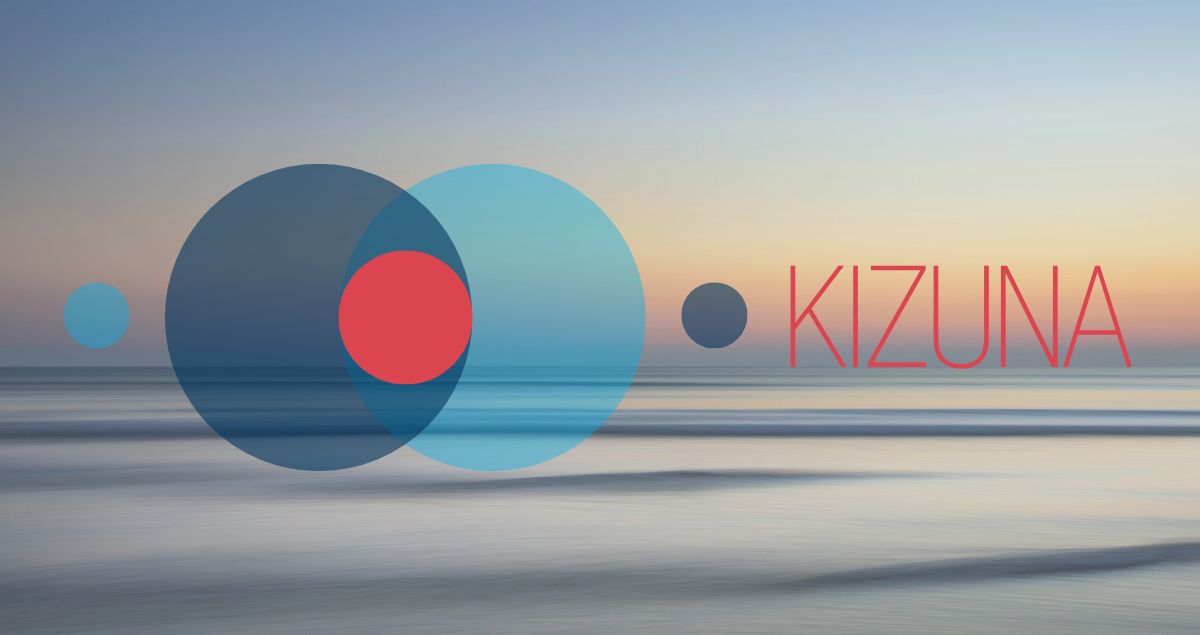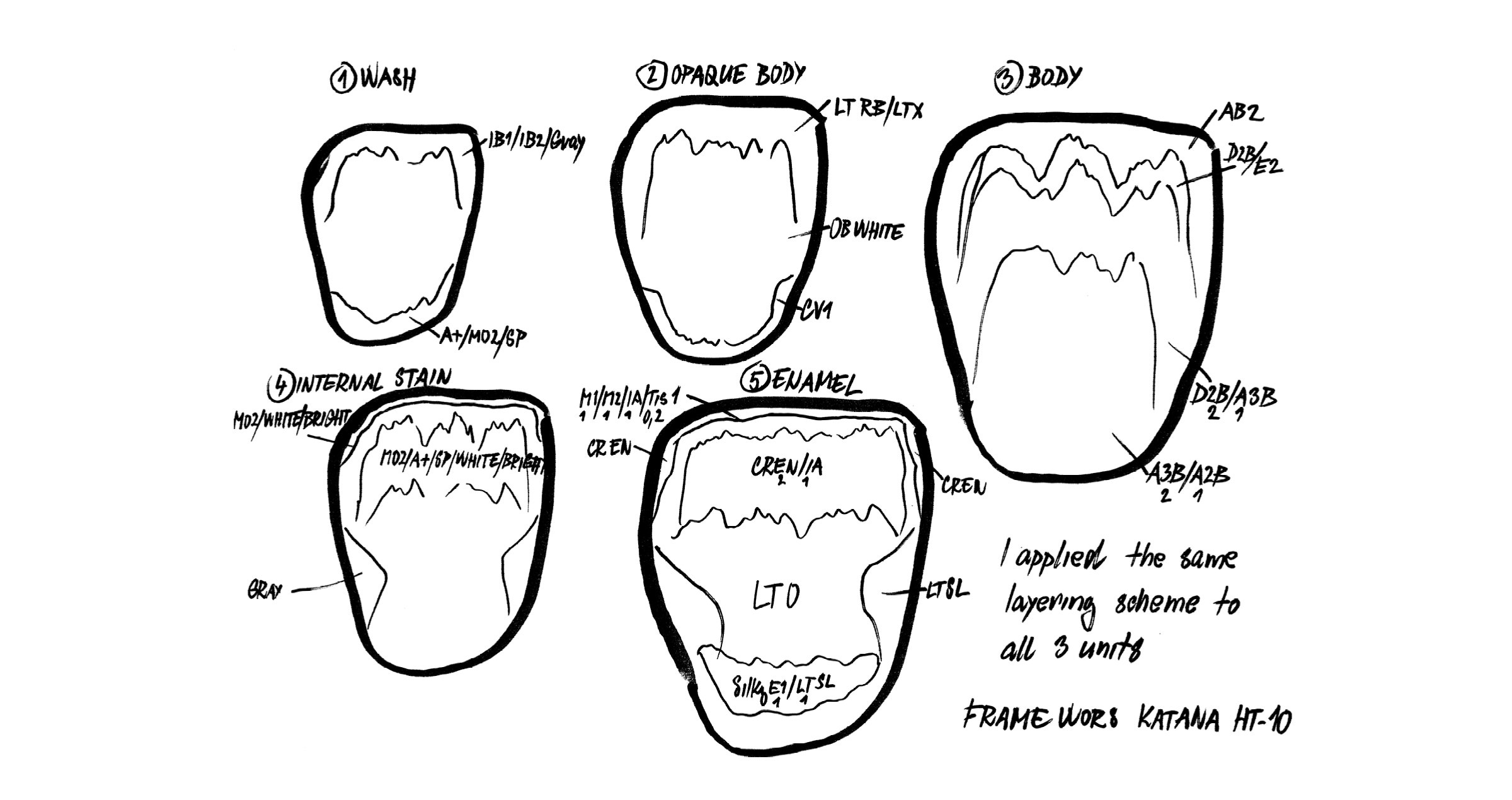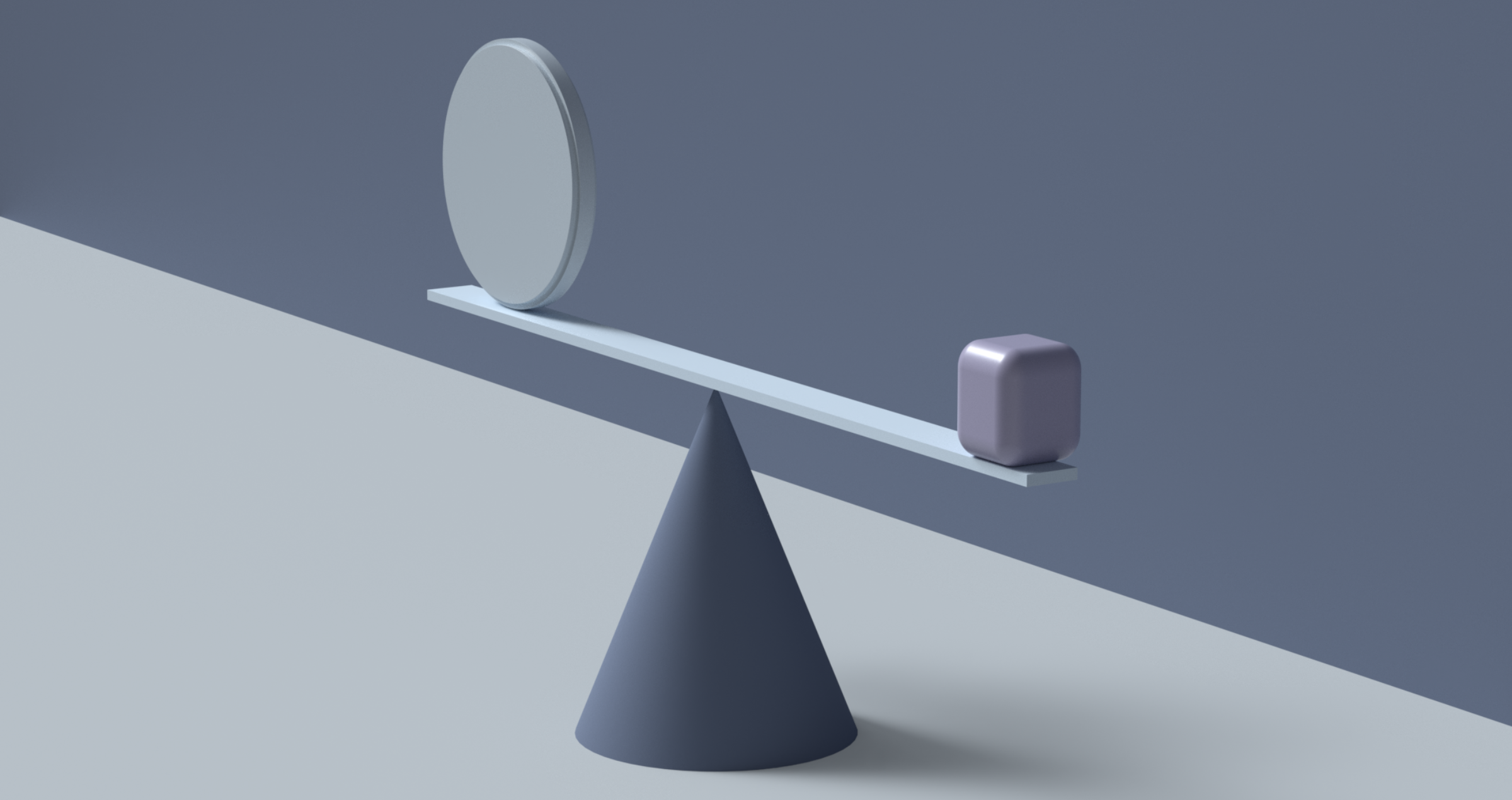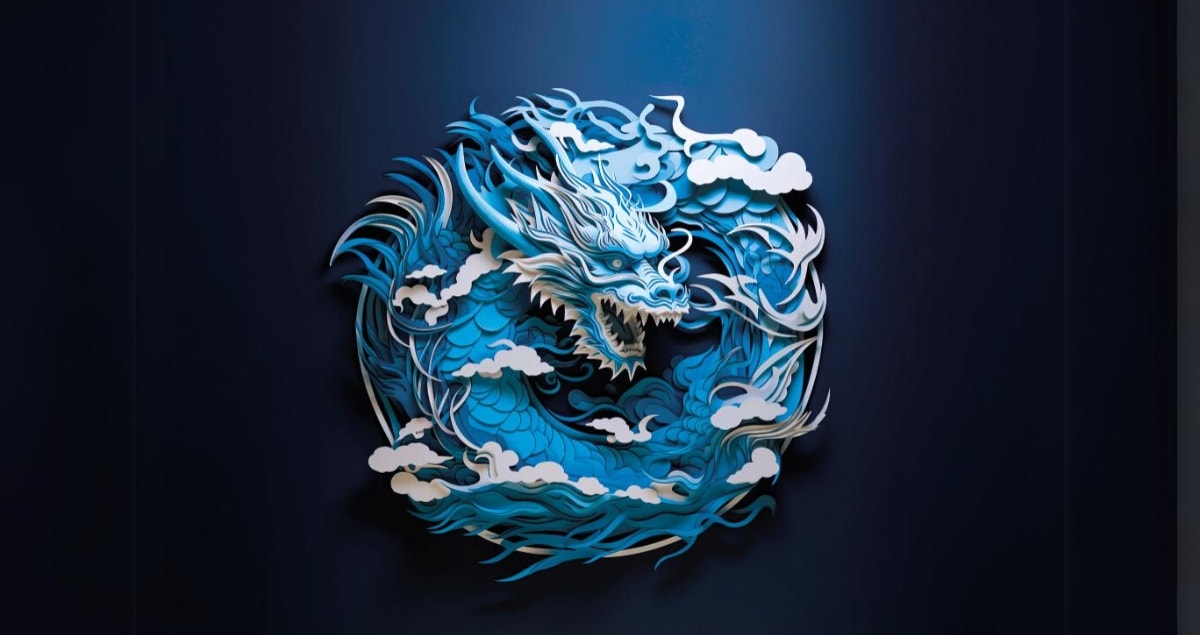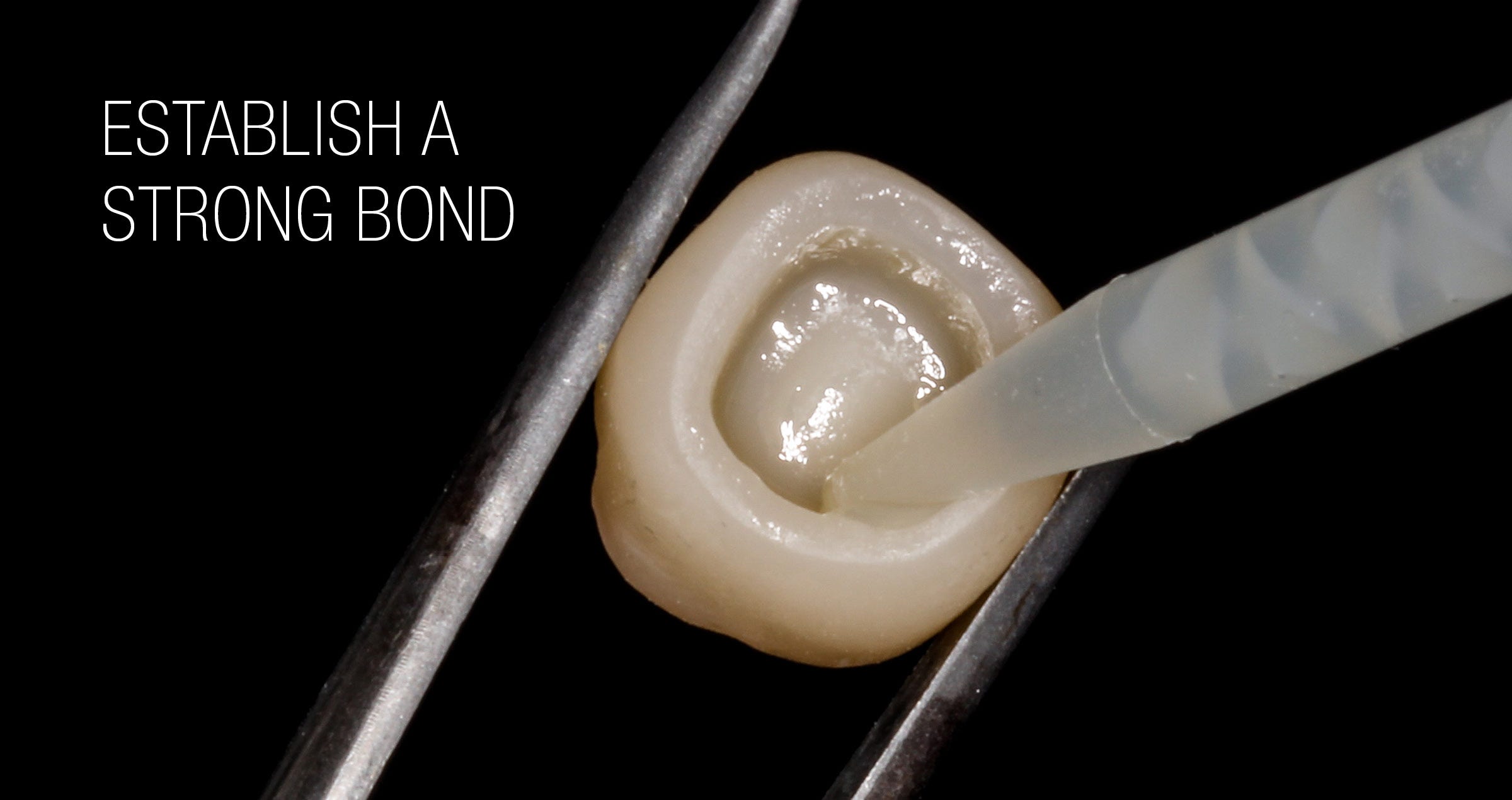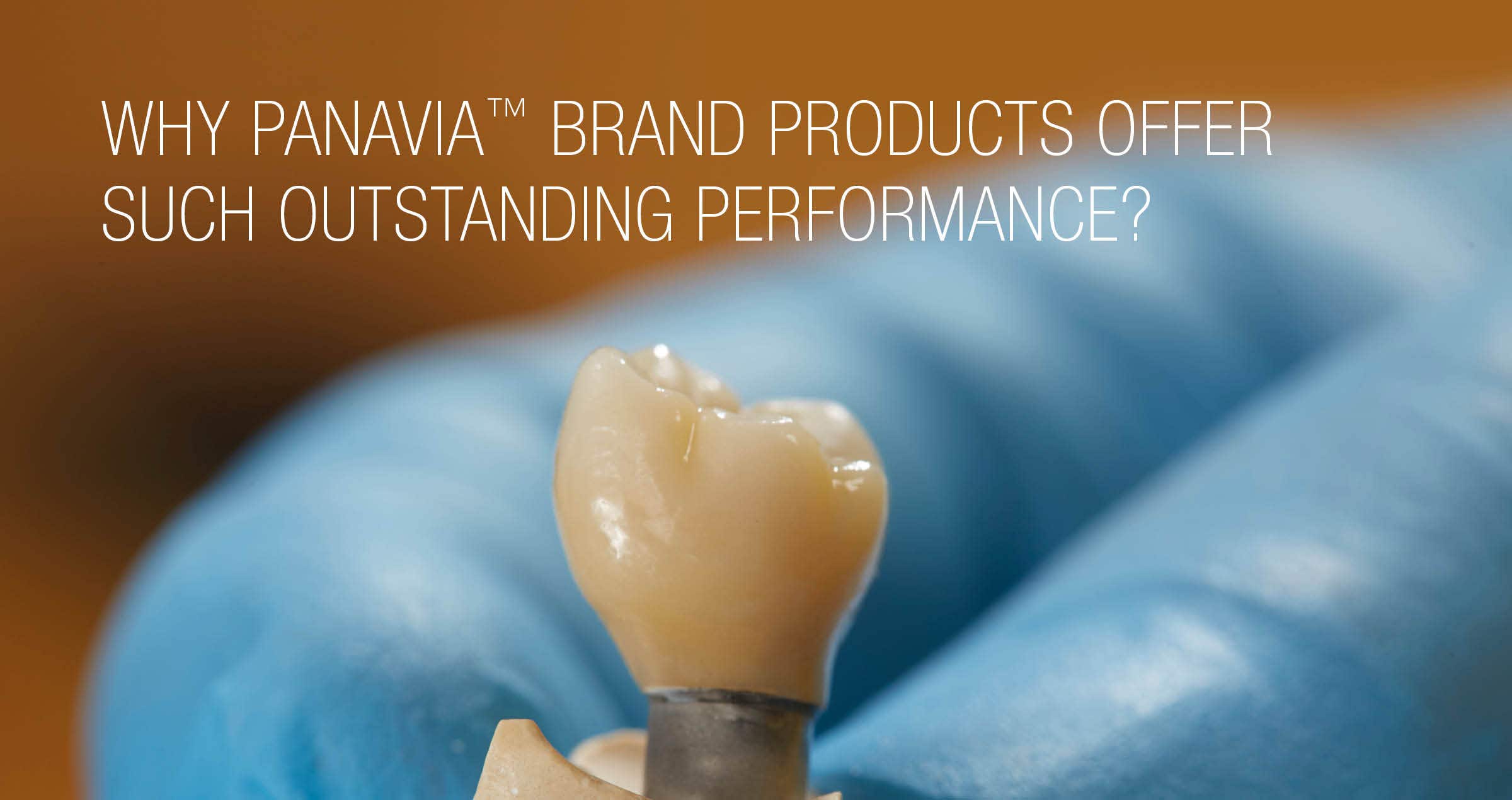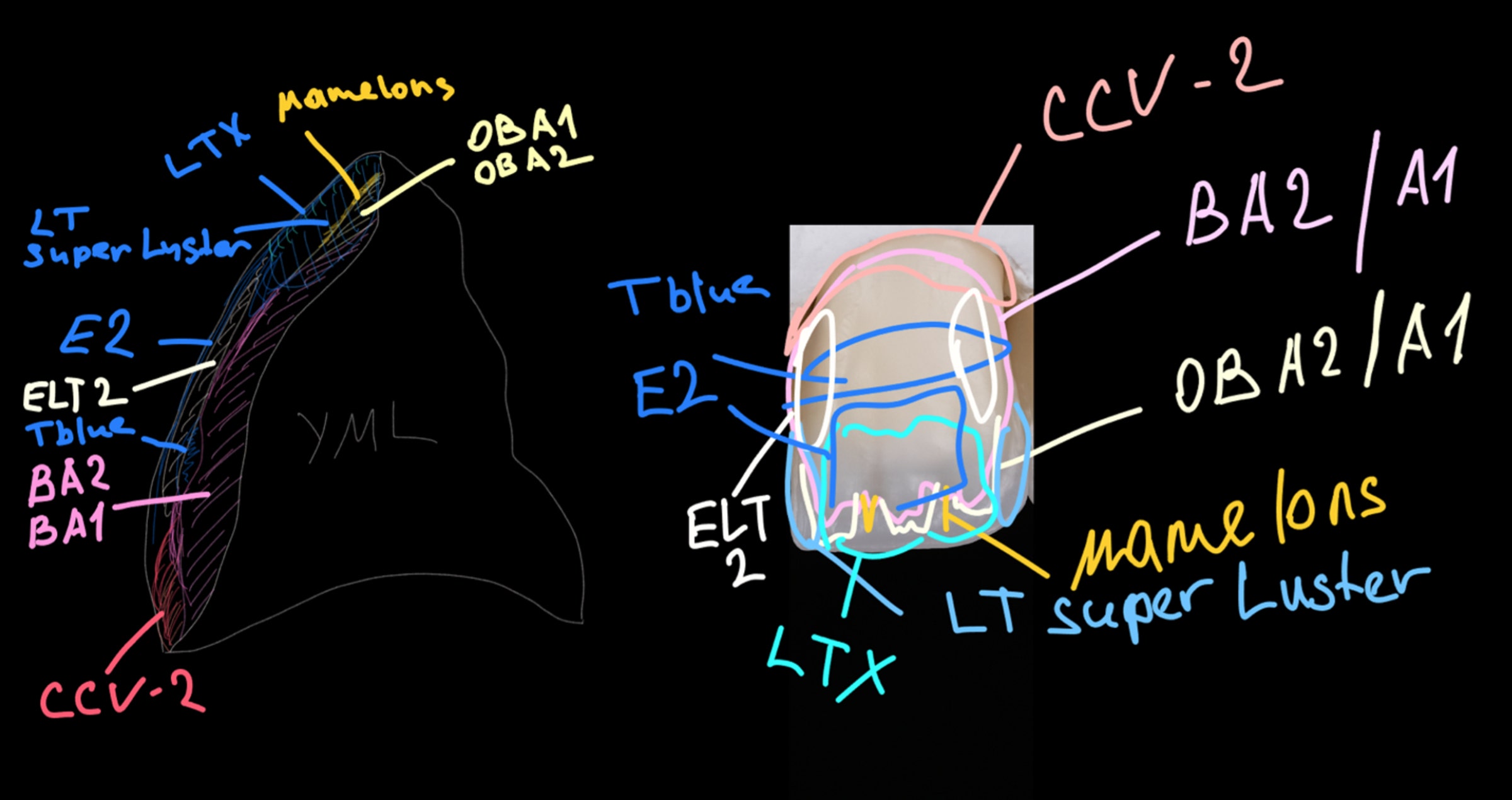Article by Dr. Adham Elsayed
Högpotenta adhesivcement är ofta möjliggörare för minimalinvasiv protetik. När målsättningen är att bevara så mycket tandstruktur som möjligt är konventionell preparationsteknik och dito cement, som kräver makromekanisk retention, vanligtvis helt uteslutet. Minimalinvasiv teknik kräver en stabil och hållbar adhesiv bindning mellan tand och erstättning – en utmaning som framgångsrikt antagits av de moderna adhesivsystemen.
Ett utmärkt exempel på minimalinvasiv preparation utan makromekanisk retention och anpassad design är etsbron med ett stöd (RBFDPs), som numera vanligen framställs av 3Y-TZP zirkonia. Med sitt enda stöd i emaljen på granntandens palatin- och approximalalyta krävs minimal, eller ingen, avverkning av frisk tandstruktur. Etsbron används vanligen för att ersätta en medfödd aplasi – i många fall den anteriaora lateralen – hos unga patienter med ofullständig dentoalveolär utveckling och trånga tandluckor som inte lämpar sig för implanatbehandling1. (Fig. 1 and 2). Andra faktorer som talar mot implantatbehandling är otillräcklig benvolym eller vinklade tandrötter. Jämfört med ortodontisk behandling i syfte att sluta en tandlucka är behandlingen med etsbro mindre riskfylld, eftersom den inte påverkar käkrelationen, förhindrar hörntandlyft eller förstör estetiken2. Slutligen är den en betydligt mindre invasiv behandling än konventionell kron- och broterapi, som vanligen inte är en lämplig behandling anteriort för unga patienter. Graden av patientnöjdhet och lyckandefrekvens när det kommer till behandling med etsbroar är imponerande3-7.
Figure 1-2: Båda lateralerna i överkäken saknas på grund av medfödd aplasi. Mjukvävnaden korrigerades och tandluckorna fylldes med entandsstödda etsbroar, tillverkade av zirkonia
Trots att entandsstödda etsbroar i zirkonia uppvisat utmärkta kliniska resultat – vid uppföljning efter 4 år visar siffrorna en överlevnad på 98.2 procent och lyckandefrekvens på 92.0 procent – väljer kliniker fortfarande efter alternativ till denna behandling. Anledningen kan vara brist på förtroende för cementets hållbarthet och bindningsstyrka till zirkonia. Den bindningen kan dock vara mycket stark och väldigt hållbar – förutsatt att några få regler efterföljs.
HUR MAN SKAPAR EN STARK BINDNING TILL TANDSTRUKTUR
För att komma fram till att en saknad tand kan ersättas med en entansstödd etsbro av zirkonia måste stödtanden noggrant undersökas. Tanden måste vara vital och fri från karies eller fyllningar och den palatinala emaljytan måste vara stor nog för resinbonding1. Dessutom krävs det plats för det palatinala stödet, vars tjocklek inte får underskrida 0.7 mm, och som kräver en design som omöjliggör påbitning på stödet för ett lyckat resultat. Preparation med ett palatinalt urtag och en liten lådpreparation aproximalt med retentionselement enbart i emaljen1, eller ingen preparation alls rekommenderas7. Vid cementeringen behandlas stödtanden som vid all cementering; efter rengöring med fluorfri tandkräm appliceras fosforsyraets på cementeringsytan, som sedan rengörs noggrant och torkas.
HUR MAN SKAPAR EN STARK BINDNING TILL ERSÄTTNINGEN
Enligt rekommendation ska stödets cementeringsyta blästras med aluminiumoxid (50 μm) på lågt tryck (ca 1 bar)8,9, åtföljt av rengöring i ultraljudbad. Figures 3 (AE) visar ordningen för ytbehandling av zirkonia. Som ett visuellt hjälpmedel för kontrollerad sandblästring kan markering av ytan med hjälp av en penna visat sig vara värdefullt. Sandblästringen ska ske efter inprovning, under vilken både tand och ersättning brukar kontaminera genom kontakt med saliv och ibland blod. De proteiner som finns i saliv och blod och som kontaminerar bindningsytan avlägsnas säkrast genom sandblästringen, som dessutom ger den ytmodifiering som krävs för stark och pålitlig bindning till det valda resincementet10.
FIGURE 3: STEG_FÖR_STEG: YTBEHANDLING FÖR ZIRKONI.
Figure 3A: Rengöring med ångspruta innan cementering
Figure 3B: Markering av bindningsytan för visuell guidning vid sandblästring
Figure 3C: Sandblästring med 50 μm Al2O3-partiklar vid 1 bars tryck
Figure 3D: Applicering av primer innehållande 10-MDP
Figure 3E: Applicering av kompositcement
VILKET RESINCEMENT SKA JAG VÄLJA?
Därefter appliceras cementeringsystemets olika komponenter. Den generella rekommendationen är användning av primer eller resincement som innehåller 10-Methacryloyloxydecyl dihydrogen phosphate (10- MDP)11. På så sätt etableras en högkvalitativ bindning. Bland de resincement som användes i långtidsstudien återfinns PANAVIA™ 21 (Kuraray Noritake Dental Inc.)4-6. Cementet som lanserades 1993, härdar utan syre och innehåller flera viktiga teknologier såsom MDP.monomeren och Touch Cure-teknologin som återfinns i PANAVIA™ V5, företagets toppmoderna, dualhärdande cementeringssystem. För att ytterligare förbättra bindningsegenskaperna har man sett över baskomponenterna, uppdaterat befintliga teknologier och kombinerat dem med helt nya ingredienser.
Också PANAVIA™ 21, som lanserades för 30 år sedan, har uppvisat höga siffror för lyckandefrekvens 4-6. De få misslyckanden som observerats beror i huvudsak chipping av ytporslin och spruckna cementlås. Ibland har orsaken varit trauma i samband med olyckor, att cementetet släppt orsakade inga ytterligare skador och ersättningarna kunde enkelt re-cementeras med samma metod och samma material.
Man skulle kunna förvänta sig att den förbättrade formulan i PANAVIA™ V5 kommer att erbjuda ännu starkare och hållbarare bindning än sina föregångare, eftersom den är ännu bättre anpassad för utmanande användningsområden som resinbondad fast protetik. En pilotstudie bekräftar detta antagande7. Utan preparation av stödtänder, men med en definierad stödyta om minst 35 mm2, cementerade forskarteamet 24 monolitiska etsbroar, framställda av KATANA™ Zirconia HT, som ersättning för medfött saknade lateraler. Centralernas palatinalytor rengjordes med pimpsten och behandlades med fosforsyra; etsbroarnas bondingytor sandblästrades med aluminumoxidpartiklar (50 μm, 2.5 bars tryck). Därefter cementerades 12 av broarna med PANAVIA™ V5, de andra tolv med PANAVIA™ F2.0 (en tidigare version av resincement från Kuraray Noritake Dental Inc.). Efter en observationsperiod om 32 till 50.47 månader, var överlevnad och lyckandefrekvensen PANAVIA™ V5-gruppen 100 procent. I den andra gruppen gick en konnektor sönder, en bro chippade och två lossnade. Baserat på dessa resultat drog studiens författare följande slutsats: ” det har konstaterats att den nya generationens cement (PANAVIA™ V5) är mera framgångsrikt”7.
SAMMANFATTNING
Under många år har minimalinvasiva direktrestaurationer, som ersättning av saknade incisiver med etsbroar, utförts framgångsrikt av vissa tandläkare. Många andra tvekar dock fortfarande över hur sådana behandlingar skulle falla ut för dem själva. Den studie som finns tillgänglig visar dock att metoden är både framgångsrik och pålitlig eftersom ständig utveckling av adhesiva cement har gett produkter som minskar risken för misslyckanden relaterade till att cementlåset havererar. Även om en ersättning lossnar är det vanligtvis ingen skada skedd och ersättningen kan enkelt re-cementeras. Dessa resultat – tillsammans med de väl kända fördelarna med minimalinvasiva behandlinsmetoder – borde uppmuntra alla tandläkare att själva utforska möjligheterna med adhesiva behandlingar. I det sammanhanget är PANAVIA™ V5 definitivt ett utmärkt materialval.
References
1. Sasse M, Kern M. All-ceramic resin-bonded fixed dental prostheses: treatment planning, clinical procedures, and outcome. Quintessence Int. 2014 Apr;45(4):291-7. doi: 10.3290/j.qi.a31328. PMID: 24570997.
2. Tetsch J, Spilker L, Mohrhardt S, Terheyden H (2020) Implant Therapy for Solitary and Multiple Dental Ageneses. Int J Dent Oral Health 6(6): dx.doi. org/10.16966/2378-7090.332.
3. Wei YR, Wang XD, Zhang Q, Li XX, Blatz MB, Jian YT, Zhao K. Clinical performance of anterior resin-bonded fixed dental prostheses with different framework designs: A systematic review and meta-analysis. J Dent. 2016 Apr;47:1-7. doi: 10.1016/j.jdent.2016.02.003. Epub 2016 Feb 11. PMID: 26875611.
4. Kern M, Passia N, Sasse M, Yazigi C. Ten-year outcome of zirconia ceramic cantilever resin-bonded fixed dental prostheses and the influence of the reasons for missing incisors. J Dent. 2017 Oct;65:51-55. doi: 10.1016/j.jdent.2017.07.003. Epub 2017 Jul 5. PMID: 28688950.
5. Kern M. Fifteen-year survival of anterior all-ceramic cantilever resin-bonded fixed dental prostheses. J Dent. 2017 Jan;56:133-135.
6. Sasse M, Kern M. Survival of anterior cantilevered all-ceramic resin-bonded fixed dental prostheses made from zirconia ceramic. J Dent. 2014 Jun;42(6):660-3. doi: 10.1016/j.jdent.2014.02.021. Epub 2014 Mar 5. PMID: 24613605.
7. Bilir H, Yuzbasioglu E, Sayar G, Kilinc DD, Bag HGG, Özcan M. CAD/CAM single-retainer monolithic zirconia ceramic resin-bonded fixed partial dentures bonded with two different resin cements: Up to 40 months clinical results of a randomized-controlled pilot study. J Esthet Restor Dent. 2022 Oct;34(7):1122-1131. doi: 10.1111/jerd.12945. Epub 2022 Aug 3. PMID: 35920051.
8. Kern M. Bonding to oxide ceramics—laboratory testing versus clinical outcome. Dent Mater. 2015 Jan;31(1):8-14. doi: 10.1016/j.dental.2014.06.007. Epub 2014 Jul 21. PMID: 25059831.
9. Kern M, Beuer F, Frankenberger R, Kohal RJ, Kunzelmann KH, Mehl A, Pospiech P, Reis B. All-ceramics at a glance. An introduction to the indications, material selection, preparation and insertion techniques for all-ceramic restorations. Arbeitsgemeinschaft für Keramik in der Zahnheilkunde. 3rd English edition, January 2017.
10. Comino-Garayoa R, Peláez J, Tobar C, Rodríguez V, Suárez MJ. Adhesion to Zirconia: A Systematic Review of Surface Pretreatments and Resin Cements. Materials (Basel). 2021 May 22;14(11):2751.
11. Al-Bermani ASA, Quigley NP, Ha WN. Do zirconia single-retainer resin-bonded fixed dental prostheses present a viable treatment option for the replacement of missing anterior teeth? A systematic review and meta-analysis. J Prosthet Dent. 2021 Dec 7:S0022-3913(21)00588-6. doi: 10.1016/j.prosdent.2021.10.015. Epub ahead of print. PMID: 34893319.


